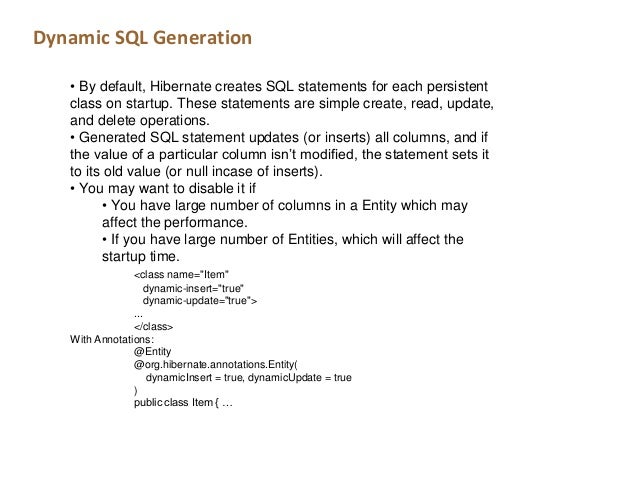Auto Generated Primary Key In Hibernate
- Foreign Key
- Auto Generated Primary Key In Hibernate 10
- Hibernate Auto Increment Primary Key In Xml
- Auto Generated Primary Key In Hibernate 2017
AUTO INCREMENT Field
Auto-increment allows a unique number to be generated automatically when a new record is inserted into a table.
Often this is the primary key field that we would like to be created automatically every time a new record is inserted.
Syntax for MySQL
The following SQL statement defines the 'Personid' column to be an auto-increment primary key field in the 'Persons' table:
Personid int NOT NULL AUTO_INCREMENT,
LastName varchar(255) NOT NULL,
FirstName varchar(255),
Age int,
PRIMARY KEY (Personid)
);
MySQL uses the AUTO_INCREMENT keyword to perform an auto-increment feature.
By simply setting our id column as SERIAL with PRIMARY KEY attached, Postgres will handle all the complicated behind-the-scenes work and automatically increment our id column with a unique, primary key value for every INSERT. Using a Custom Sequence. In some rare cases, the standard incremental nature built into the SERIAL and BIGSERIAL data types may not suit your.
By default, the starting value for AUTO_INCREMENT is 1, and it will increment by 1 for each new record.
Foreign Key
Using Hibernate to generate id incrementally As we have seen in the last section that the increment class generates identifiers of type long, short or int that are unique only when no other process is inserting data into the same table. In this lesson I will show you how to write running program to demonstrate it. Oct 21, 2009 This discussion is archived. 2 Replies Latest reply Latest reply. For a relational database like PostgreSQL, it could widely be considered a sin among developers not to include a primary key in every table. It is therefore crucial that you do your utmost to add that all-important primary key column to every table, and thankfully Postgres provides two methods for accomplishing this task. @Id and @GeneratedValue: are used in conjunction for a field that maps to the primary key. The values for this field are auto generated. @Temporal: must be used with a java.util.Date field to specify the actual SQL type of the column. @OneToOne and @JoinColumn: are used together to specify a one-to-one association and the join column. JPA and Hibernate support different strategies to generate primary key values. One of them is the identity strategy which uses an auto-incremented database column. If you want to use this strategy, you have to annotate the primary key attribute @Id and with the @GeneratedValue annotation and set the strategy attribute to GenerationType.IDENTITY. Jan 07, 2020 Auto increment columns widely used for auto-generating values for primary keys in Database tables.Most of the databases like SQL server etc have existing features to create auto increment columns. In Oracle 12c they introduced IDENTITY columns which allows users to create auto increment columns.
To let the AUTO_INCREMENT sequence start with another value, use the following SQL statement:
To insert a new record into the 'Persons' table, we will NOT have to specify a value for the 'Personid' column (a unique value will be added automatically):
VALUES ('Lars','Monsen');
The SQL statement above would insert a new record into the 'Persons' table. The 'Personid' column would be assigned a unique value. The 'FirstName' column would be set to 'Lars' and the 'LastName' column would be set to 'Monsen'.
Syntax for SQL Server
The following SQL statement defines the 'Personid' column to be an auto-increment primary key field in the 'Persons' table:
Personid int IDENTITY(1,1) PRIMARY KEY,
LastName varchar(255) NOT NULL,
FirstName varchar(255),
Age int
);
The MS SQL Server uses the IDENTITY keyword to perform an auto-increment feature.
In the example above, the starting value for IDENTITY is 1, and it will increment by 1 for each new record.
Tip: To specify that the 'Personid' column should start at value 10 and increment by 5, change it to IDENTITY(10,5).
To insert a new record into the 'Persons' table, we will NOT have to specify a value for the 'Personid' column (a unique value will be added automatically):

VALUES ('Lars','Monsen');
The SQL statement above would insert a new record into the 'Persons' table. The 'Personid' column would be assigned a unique value. The 'FirstName' column would be set to 'Lars' and the 'LastName' column would be set to 'Monsen'.
Syntax for Access
The following SQL statement defines the 'Personid' column to be an auto-increment primary key field in the 'Persons' table:
Personid AUTOINCREMENT PRIMARY KEY,
LastName varchar(255) NOT NULL,
FirstName varchar(255),
Age int
);
The MS Access uses the AUTOINCREMENT keyword to perform an auto-increment feature.
By default, the starting value for AUTOINCREMENT is 1, and it will increment by 1 for each new record.
Tip: To specify that the 'Personid' column should start at value 10 and increment by 5, change the autoincrement to AUTOINCREMENT(10,5).
Auto Generated Primary Key In Hibernate 10
To insert a new record into the 'Persons' table, we will NOT have to specify a value for the 'Personid' column (a unique value will be added automatically):
VALUES ('Lars','Monsen');
The SQL statement above would insert a new record into the 'Persons' table. The 'Personid' column would be assigned a unique value. The 'FirstName' column would be set to 'Lars' and the 'LastName' column would be set to 'Monsen'.
Hibernate Auto Increment Primary Key In Xml
Syntax for Oracle
In Oracle the code is a little bit more tricky.
You will have to create an auto-increment field with the sequence object (this object generates a number sequence). Ark survival evolved key generator torrent.

Auto Generated Primary Key In Hibernate 2017
Use the following CREATE SEQUENCE syntax:
MINVALUE 1
START WITH 1
INCREMENT BY 1
CACHE 10;
The code above creates a sequence object called seq_person, that starts with 1 and will increment by 1. It will also cache up to 10 values for performance. The cache option specifies how many sequence values will be stored in memory for faster access.
To insert a new record into the 'Persons' table, we will have to use the nextval function (this function retrieves the next value from seq_person sequence):
VALUES (seq_person.nextval,'Lars','Monsen');
The SQL statement above would insert a new record into the 'Persons' table. The 'Personid' column would be assigned the next number from the seq_person sequence. The 'FirstName' column would be set to 'Lars' and the 'LastName' column would be set to 'Monsen'.